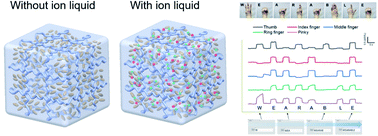Humidity-resistive, elastic, transparent ion gel and its use in a wearable, strain-sensing device†
Abstract
With the growing interest in human–electronics interaction, the development of ion gels that operate in response to variable human movement is widely spreading. However, conventional ion gels, based on hydrogel and non-hydrogel materials, have the fatal disadvantages of vulnerability to humidity and lack of transparency. Therefore, the need for an ion gel to satisfy all the requirements of elasticity, toughness, transparency, conductivity, and strong resistivity under humidity is emerging. Here, we demonstrate a polyvinylchloride (PVC)-based conductive ion gel with humidity-insensitive properties. To impart conductivity to the PVC gel, we use an ionic liquid. The prepared ion gel retains its elasticity with repeated tensile cycles of (200% strain) up to thirty times, and it exhibits ∼93% transparency and ∼40 kJ m−3 of toughness. In addition, excellent performance of this ion gel as a strain sensor was obtained, giving a conductivity increase with the factor of 100 compared with raw PVC gel. We show its application in human motion using a glove attached to the ion gel to monitor sign language and control a mouse pointer on the screen.



 Please wait while we load your content...
Please wait while we load your content...